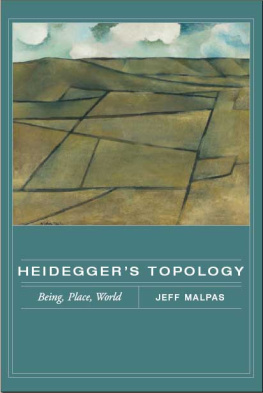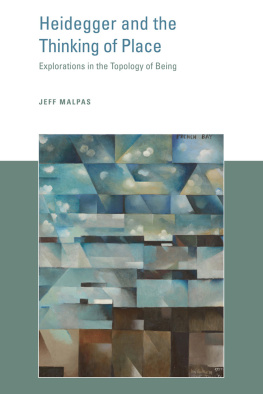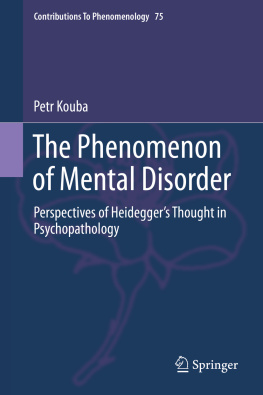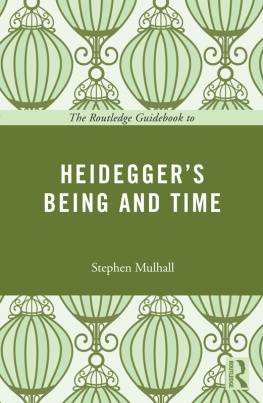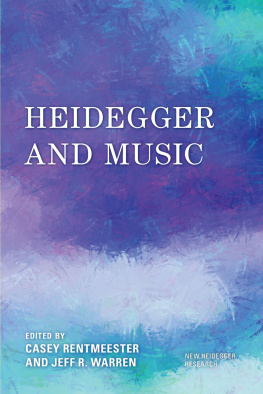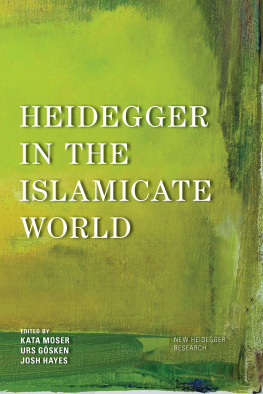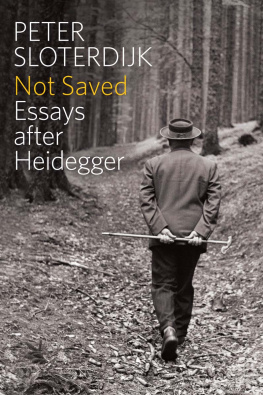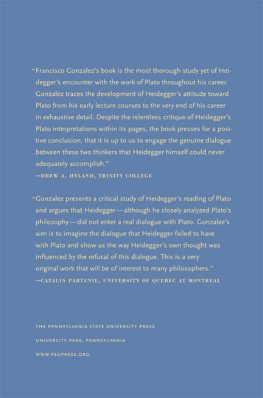Heidegger Martin - Heideggers topology: being, place, world
Here you can read online Heidegger Martin - Heideggers topology: being, place, world full text of the book (entire story) in english for free. Download pdf and epub, get meaning, cover and reviews about this ebook. City: Cambridge, year: 2008, publisher: MIT Press, genre: Politics. Description of the work, (preface) as well as reviews are available. Best literature library LitArk.com created for fans of good reading and offers a wide selection of genres:
Romance novel
Science fiction
Adventure
Detective
Science
History
Home and family
Prose
Art
Politics
Computer
Non-fiction
Religion
Business
Children
Humor
Choose a favorite category and find really read worthwhile books. Enjoy immersion in the world of imagination, feel the emotions of the characters or learn something new for yourself, make an fascinating discovery.
- Book:Heideggers topology: being, place, world
- Author:
- Publisher:MIT Press
- Genre:
- Year:2008
- City:Cambridge
- Rating:4 / 5
- Favourites:Add to favourites
- Your mark:
- 80
- 1
- 2
- 3
- 4
- 5
Heideggers topology: being, place, world: summary, description and annotation
We offer to read an annotation, description, summary or preface (depends on what the author of the book "Heideggers topology: being, place, world" wrote himself). If you haven't found the necessary information about the book — write in the comments, we will try to find it.
A groundbreaking argument that the concept of place is central to Heideggers thinkingand at the heart of all philosophical inquiry.
Heideggers topology: being, place, world — read online for free the complete book (whole text) full work
Below is the text of the book, divided by pages. System saving the place of the last page read, allows you to conveniently read the book "Heideggers topology: being, place, world" online for free, without having to search again every time where you left off. Put a bookmark, and you can go to the page where you finished reading at any time.
Font size:
Interval:
Bookmark:
Jeff Malpas
The MIT Press
Cambridge, Massachusetts
London, England
2006 Massachusetts Institute of Technology
All rights reserved. No part of this book may be reproduced in any form by any electronic or mechanical means (including photocopying, recording, or information storage and retrieval) without permission in writing from the publisher.
MIT Press books may be purchased at special quantity discounts for business or sales promotional use. For information, please e-mail or write to Special Sales Department, The MIT Press, 55 Hayward Street, Cambridge, MA 02142.
This book was set in Stone Serif and Stone Sans by SNP Best-set Typesetter Ltd., Hong Kong, and was printed and bound in the United States of America.
Library of Congress Cataloging-in-Publication Data
Malpas, J. E.
Heideggers topology : being, place, world / by Jeff Malpas.
p. cm.
Includes bibliographical references and index.
ISBN-13: 978-0-262-13470-5 (hc : alk. paper)
ISBN-10: 0-262-13470-5 (hc : alk. paper)
1. Heidegger, Martin, 1889-1976. 2. Place (Philosophy). I. Title.
B3279.H49M272 2007
111'.092dc22
2006046709
10 9 8 7 6 5 4 3 2 1
Acknowledgments
1 Introduction: Heidegger, Place, and Topology
2 Beginning in Place
3 The Ontology of Existence: Meaning and Temporality
4 The Turning of Thought: Truth and World
5 The Poetry That Thinks: Place and Event
6 Conclusion: Returning to Place
Notes
Select Bibliography
Index
Things exist rooted in the flesh,
Stone, tree and flower.... Space and time
Are not the mathematics that your will
Imposes, but a green calendar
Your heart observes; how else could you
Find your way home or know when to die...
R. S. Thomas, Green Categories
This book has taken rather longer to write than I ever anticipated. Indeed, it is a book for which a partial version already existed at the beginning of 1999. Administrative and other duties prevented me from pursuing the project, however, and the final version actually represents a major reworking and rewriting of the original materialindeed, there is very little of the original that remains. Although a considerable amount of work had thus already been undertaken beforehand, the core elements in the book were actually developed in a series of articles published between 2001 and 2004 and in the reworking of that material between the end of 2003 and the middle of 2004. Over this period the research was supported by the School of Philosophy at the University of Tasmania, by a Large Grant from the Australian Research Council (from 2001-2003), and by a six-month stay, from May to October of 2004, at Ludwig-Maximilians-Universitt in Munich, where I was fortunate enough to be able to resume the Humboldt Fellowship that I had originally held at the University of Heidelberg in 1998-1999.
I would like to thank the University of Tasmania and Ludwig- Maximilians-Universitt Munich, as well the Australian Research Council and the Alexander von Humboldt Foundation for the support they have given this project. Special thanks are also due to a number of individuals: Andrew Benjamin, Ed Casey, Bert Dreyfus, Stuart Elden, Joseph Fell, Karl Homann (my host in Munich), Marcelo Stamm (who deserves special thanks and acknowledgment for his generosity in allowing my wife and myself to use his Munich apartment during the time this book was written), Peter Steiner, Reinhard Steiner, James Phillips (for being one of my best-ever postgraduate students and also for assisting with the final corrections and revisions), and Julian Young (for many long discussions on dwelling and other topics over the years and for much else besides).
A note on referencing: Except in a few cases in which the English text appears in a dual English/German edition, all references in the text to English translations of Heideggers works are followed by a reference to the original German source in parentheseswhere the relevant volume appears in Heideggers Gesamtausgabe (Complete Works), the reference is given as GA followed by volume number and page number, for example: (GA, 13:84).
But poetry that thinks is in truth the topology of Being...
Heidegger, The Thinker as Poet
This book has its origins in two ideas: first, that a central, if neglected, concept at the heart of philosophical inquiry is that of place; and, second, that the concept of place is also central to the thinking of the key twentieth-century philosopher, Martin Heidegger. Originally the material dealt with in these pages was intended to form part of a single investigation into the nature and significance of place. As work on that volume proceeded, however, it soon became obvious that it would be difficult to deal with the Heidegger material in a way that did justice to it while also allowing the development of the broader inquiry into place as such. As a result, the volume that appeared with Cambridge University Press in 1999, Place and Experience: A Philosophical Topography, while it included some brief discussion of Heidegger, was focused on the task of establishing the philosophical nature and significance of place, leaving the main investigation of the role of place in Heidegger for another worka work that was projected in the pages of Place and Experience under the title Heideggers Topology of Being.
The title may have changed slightly, but the present volume aims to make good on that original commitment and can be regarded as something of a companion volume to Place and Experience (in fact, since I am now working on a third volume, Triangulating Davidson, that will develop a place-oriented reading of Donald Davidsons work on language, mind, and understanding, the original project now seems to have turned into a trilogy of works). Moreover, while Heidegger is a central focus here, and the work aims to provide an account of the role and significance of place in relation to Heidegger, the book also contains material that can be viewed as expanding and supplementing elements of the original analysis in Place and Experience. This is especially so as regards a number of methodological issues surrounding the idea of what I have called topography and that appears in Heidegger as topology. In this respect, Heideggers Topology can be viewed as providing, not only a particular way of reading Heideggers thought in its entirety, but also a more detailed investigation of the way in which the concept of place relates to certain core philosophical issues such as the nature of ground, of the transcendental, and of concepts of unity, limit, and bound, as well as a further defense of the philosophical significance and legitimacy of place.
In taking place as the central concept in Heideggers thought, the aim is to be able to arrive at a more basic and, one hopes, more illuminating understanding of that thought and so also, perhaps, a more basic and illuminating appropriation of it into an English-speaking contextan understanding, moreover, that shows how that thought originates, not in some peculiar and special intuition of being, but rather in the simple and immediate grasp of being in our own being-in the open-ness of place. In this respect, what I offer here is a very specific reading of Heidegger, one that aims to understand him as responding to a particular problem or set of problems and that aims to bring to the fore an issue that is otherwise not always directly apparent in Heideggers thinking either as he himself formulates it or as it is interpreted by others, but which is nevertheless foundational to that thinking. The aim, in fact, is to bring to light something in Heideggers thinking that perhaps he could not have himself fully articulated and that indeed remains, to some extent, to be recovered from that work. That the task of reading Heidegger will indeed involve a certain struggle both with Heidegger, and sometimes even against him, seems to me an inevitable result of any attempt to engage with Heidegger as a live thinker rather than a mere text. It also means, however, that my account may be viewed as simply putting too much stress on certain elements at the expense of others. This is a criticism that I am happy to accept, although I leave it up to the reader to judge whether the way of reading proposed does not bring certain advantages with it not least in terms of advancing the understanding of the underlying concepts and problems that seem to be at issue here.
Font size:
Interval:
Bookmark:
Similar books «Heideggers topology: being, place, world»
Look at similar books to Heideggers topology: being, place, world. We have selected literature similar in name and meaning in the hope of providing readers with more options to find new, interesting, not yet read works.
Discussion, reviews of the book Heideggers topology: being, place, world and just readers' own opinions. Leave your comments, write what you think about the work, its meaning or the main characters. Specify what exactly you liked and what you didn't like, and why you think so.

